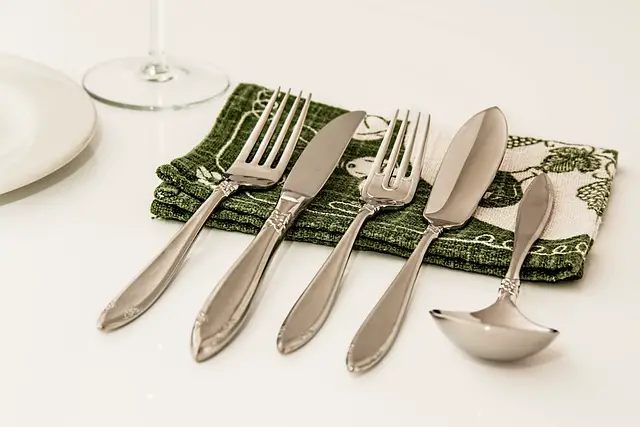Cutlery refers to knives and tools used for cutting and eating, while utensils encompass a broader range of tools for cooking, serving, and eating.
TL;DR Cutlery Vs. Utensils
Cutlery refers specifically to knives, forks, and spoons that are typically made of metal. It is primarily used for cutting, spearing, and scooping food. Cutlery often has a more refined and elegant design, making it suitable for formal occasions or fine dining experiences.
Utensils encompass a broader category of tools used in cooking and eating. This includes items like spatulas, tongs, ladles, whisks, and more. Utensils can be made from various materials such as wood or plastic.
What is cutlery?

Cutlery refers to a collection of hand-held tools primarily designed for cutting, preparing, and consuming food.
It includes a variety of utensils, typically made from materials like stainless steel, silver, or other metals, designed for specific culinary tasks. The essential components of cutlery include knives, forks, and spoons.
Knives are the central element of cutlery and come in various shapes and sizes, each tailored to particular cutting tasks, such as paring, slicing, and carving.
Forks are used for spearing and holding food while cutting or eating, and spoons are designed for scooping and stirring. Other specialized utensils, like butter knives, steak knives, and dessert spoons, also fall under the cutlery category.
What are utensils?

Utensils are a broad category of tools and implements used in various tasks related to cooking, serving, and eating. They encompass an array of items designed to handle different stages of food preparation, from the initial ingredients to the final dining experience.
Utensils are made from a variety of materials, including metals, plastics, wood, and ceramics, each chosen for its specific function and compatibility with food.
Common utensils include spatulas, ladles, tongs, whisks, and mixing spoons, which aid in stirring, flipping, and blending ingredients during cooking.
Others, like cutting boards and peelers, are essential for safe and efficient food preparation. Serving utensils, such as serving spoons and forks, facilitate the transfer of cooked dishes to plates.
Cutlery Vs. Utensils – Key differences
| Aspect | Cutlery | Utensils |
|---|---|---|
| Definition | Tools for cutting, preparing, and eating | Broad category of tools for cooking, serving, and eating |
| Main Components | Knives, forks, spoons | Spatulas, ladles, tongs, whisks, etc. |
| Material | Often metal (stainless steel, silver) | Varied (metal, plastic, wood, ceramics) |
| Usage | Primarily for cutting and eating | For cooking, serving, and food preparation |
| Cultural Significance | Reflects dining etiquette and traditions | Reflects cooking methods and cuisine |
| Placement | Typically set at individual place settings | Used in cooking process and serving |
| Dining Table | Used during meal consumption | Used for cooking and serving meals |
| Variety | Limited to knives, forks, spoons | Wide range including various tools |
| Culinary Artistry | Used for consuming prepared dishes | Used for cooking and food preparation |
Uses of Utensils and Cutlery
Uses of Utensils
Cooking Preparation
Utensils like spatulas, whisks, and mixing spoons are used for stirring, blending, and folding ingredients during cooking.
Food Handling
Tongs and forks are employed to flip and turn food items while cooking to ensure even cooking on both sides.
Cutting and Peeling
Peelers and knives aid in removing the outer layers of fruits and vegetables or cutting them into desired shapes.
Uses of Cutlery:
Eating
Forks, knives, and spoons are used to consume a wide variety of foods, each serving a specific purpose in eating.
Cutting and Chopping
Knives are essential for cutting, slicing, and chopping ingredients before cooking or during meal preparation.
Spearing and Holding
Forks are used to spear food items for cutting or holding while consuming.
Image Credits
Featured Image By – Walter Bichler from Pixabay
Image 1 By – Steve Buissinne from Pixabay
Image 2 By – Mikes-Photography from Pixabay








